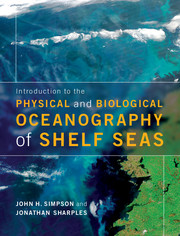Book contents
- Frontmatter
- Contents
- Preface
- Acknowledgements
- Guide to the book and how to make the best use of it
- Symbols
- 1 Introduction to the shelf seas
- 2 Physical forcing of the shelf seas: what drives the motion of ocean?
- 3 Response to forcing: the governing equations and some basic solutions
- 4 Waves, turbulent motions and mixing
- 5 Life in the shelf seas
- 6 Seasonal stratification and the spring bloom
- 7 Interior mixing and phytoplankton survival in stratified environments
- 8 Tidal mixing fronts: their location, dynamics and biological significance
- 9 Regions of freshwater influence (ROFIs)
- 10 The shelf edge system
- 11 Future challenges in shelf seas
- Glossary
- Answers to chapter problems
- References
- Index
- Plate section
7 - Interior mixing and phytoplankton survival in stratified environments
Published online by Cambridge University Press: 05 June 2012
- Frontmatter
- Contents
- Preface
- Acknowledgements
- Guide to the book and how to make the best use of it
- Symbols
- 1 Introduction to the shelf seas
- 2 Physical forcing of the shelf seas: what drives the motion of ocean?
- 3 Response to forcing: the governing equations and some basic solutions
- 4 Waves, turbulent motions and mixing
- 5 Life in the shelf seas
- 6 Seasonal stratification and the spring bloom
- 7 Interior mixing and phytoplankton survival in stratified environments
- 8 Tidal mixing fronts: their location, dynamics and biological significance
- 9 Regions of freshwater influence (ROFIs)
- 10 The shelf edge system
- 11 Future challenges in shelf seas
- Glossary
- Answers to chapter problems
- References
- Index
- Plate section
Summary
In the last chapter we developed an understanding of the basic seasonal competition between heating and stirring, in which the mixing was driven by frictional stresses at the water column boundaries. In this chapter we shall describe the generally far weaker mixing which occurs across density interfaces within the interior of the water column. We will illustrate the physics involved using more detailed models of the interaction between buoyancy input and vertical mixing processes in the seasonally stratified regime. We will show where the models fail in their descriptions of mixing and how correcting these failings is vital if we are to understand and model the survival and growth of phytoplankton in stratified waters.
Pycnoclines often separate biochemically distinct regimes in the water column: high light and low nutrients near the sea surface, low light and high nutrients near the seabed. The inherent stability of a pycnocline can provide a niche for phytoplankton that contains both sufficient light and nutrients for survival. We will describe the links between physical and biological processes that lead to the survival of phytoplankton; you will see that understanding the processes that drive turbulence within and across pycnoclines lies at the heart of the growth and distribution of the primary producers.
- Type
- Chapter
- Information
- Publisher: Cambridge University PressPrint publication year: 2012



